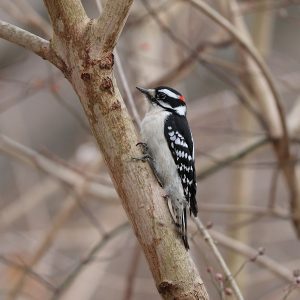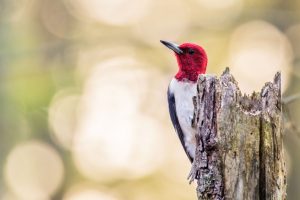Nature Matters: Wonderful Woodpeckers Part II
By John L. Turner
Part Two

Of the twenty-two species found in North America (twenty-three if you’re optimistic the Ivory-billed Woodpecker still exists and who doesn’t hope that?) we have seven woodpecker species inhabiting Long Island’s forests.
The Pileated is the largest, being about the same size as the American Crow. It is the “Woody Woodpecker” of woodpeckers! They have begun to repopulate Long Island after a long absence, benefitting from the maturing forests of large trees in protected parks and preserves.
I saw my first Long Island Pileated earlier this year in the Humes Preserve in northern Nassau County, when a male broke out from the tree line and flew across a long meadow before reaching the woods on the other side, providing a five second view of this unmistakable species. Running to the point where it had re-entered the forest I enjoyed closer views of the bird banging away on the bark of a tree, interspersed with the bird’s raucous call. If you hear them on a hike, look around on tree trunks for their distinctive, rectangular-shaped excavation holes they make in search of beetle grubs, their favorite prey.

In contrast, the Downy Woodpecker is the smallest of the Island’s woodpeckers and is also quite common, with almost every forest and suburban woodlot hosting a pair of Downies, where they often reveal their presence by their downward slurring “whinny” call. Recently, in a property on the west side of the Nissequogue River, I watched a pair of Downies fly into a nearby black walnut tree and perform a courtship dance. The two forms moved in jerky robotic motions responding to each other — a crazy motion following short bouts of stillness broken once again by motion. This went on for thirty seconds or so before they flew off, leaving a smile on my face.
The Downy Woodpecker’s slightly larger cousin — the Hairy Woodpecker — is also common and widespread in New York. The Hairy prefers deeper, more intact forests than does the Downy. These two species are easily confused. One clue to distinguish them is found in the white outer tail feathers of the two species. A long time ago, as a youthful birder, I learned this clue: the Downy Woodpecker has black spots on its feather while the Hairy lacks them, which I put to memory using a mnemonic device “The Downy has dots while the Hairy hasn’t”; the Hairy’s bill is also proportionally larger.
The most beautiful woodpecker that calls Long Island home is undoubtedly the Red-headed Woodpecker. No other woodpecker, or bird in North America for that matter, has the Red-headed’s striking color combination of a brilliant red head and black and white wings and body. Unfortunately, breeding bird data indicates this species is in fairly rapid decline in the state although the cause(s) has not been fully identified.

One reported cause is being hit by cars due to its habit of hawking for insects flying over roads. They are a rare breeder here. Several years ago a breeding pair nested in Manorville but seems to have vacated the area and there is currently breeding activity in the Flanders of the Pine Barrens.
It’s relative, the Red-bellied Woodpecker, shows a reverse trend in the state, as this woodpecker, once of a more southerly distribution, has rapidly increased in abundance. In fact, in Ludlow Griscom’s 1923 Birds of the New York City Region, the Red-bellied is reported as being a very rare bird having been seen merely three times in the area, the last being in 1895. However, by the 1960’s the species was well established and has continued to expand its range northward, being a confirmed breeder in slightly more than one-third of the census blocks in the 2005 NYS Breeding Bird Atlas. The bird is now a common breeder here and its breeding range has extended as far north as mid-New England. They are found in virtually every wooded park on Long Island.
The Northern Flicker, the males being distinguished from females by the black mustache mark they possess, is the most widespread woodpecker in New York. A lover of ants, the Flicker spends more time on the ground to feed on them than any other woodpecker. This predilection for ants, which are unavailable in the winter, is the main reason why flickers are among the most highly migratory of all woodpeckers.
I remember hiking several decades ago through a park in the Long Island Pine Barrens where a wildfire had burned off the forest floor and understory, exposing countless large ant mounds. For the next several weeks I saw Flickers commonly here, taking advantage of countless ants exposed by the fire.
This leaves, for last, the Yellow-bellied Sapsucker, a bird that, as the name suggests, has a diet different than it’s brethren. Sapsuckers routinely drill small holes, typically parallel rows, in thin barked trees and routinely return to lap up the sap and any small insects attracted to it with their aforementioned brush-like tongues. This species doesn’t breed here, raising its young further north, but both adults and immatures can be seen on Long Island, especially during fall migration.
There are two other woodpecker species found in New York State but not on Long Island — the Black-backed and Three-toed Woodpeckers. These are Adirondack specialties where they inhabit dense spruce forests. Both species share the basic black-and-white pattern of most other woodpeckers but instead of having red crowns possess yellow ones. They are also distinctive by the three toed feet they have rather than four. They are most abundant in forests where fire has killed swaths of trees, setting the stage for the many beetles that feast on the dead wood. While disturbance like wildfires typically can adversely affect wildlife, woodpeckers are a group of birds that can benefit from perturbations in the environment.
Whether it’s their unique behavior, impressive anatomical adaptations, or ecological importance due to their cavity making abilities, the native woodpecker species of Long Island are an interesting and important part of nature’s fabric here. Why not spend some time getting to know the species which inhabit yards, parks and woodlands in your neighborhood?
Part I of Wonderful Woodpeckers appeared in the issue of October 24. Read it here.
A resident of Setauket, author John L. Turner is a naturalist, conservation co-chair of the Four Harbors Audubon Society, and Conservation Policy Advocate for the Seatuck Environmental Association.







